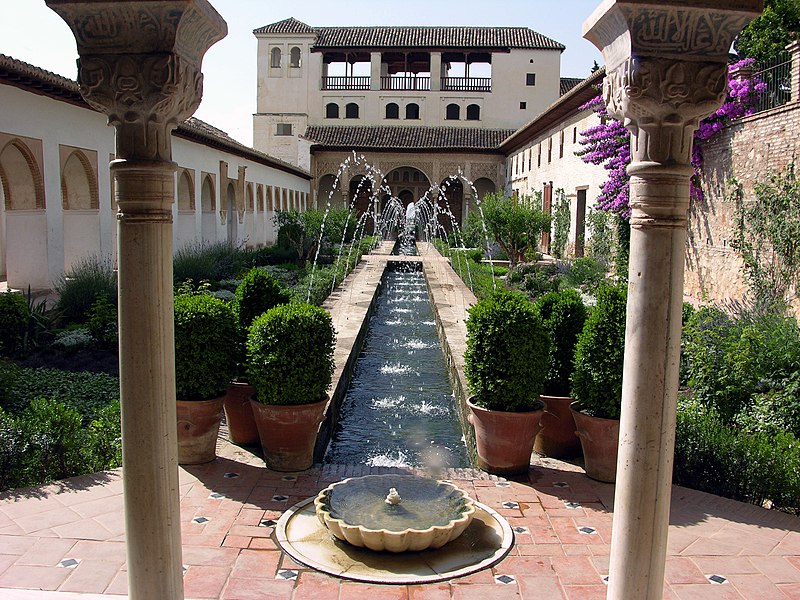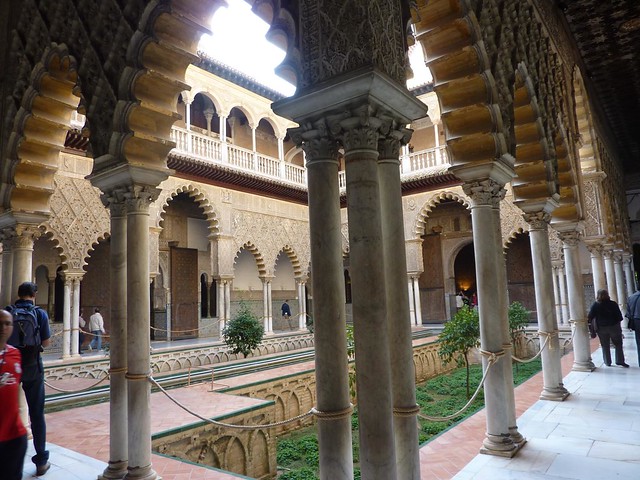Gosh, it’s been a while, hasn’t it? The main distractions keeping me away from posting have been a couple of classes I’ve been taking to fill in some art history holes I hadn’t bothered with before. For one of them I’ve been doing a little research on Granada’s Patio de la Acequia, the “Courtyard of the Aqueduct,” one of the gardens at the Generalife, the garden fortress across the canyon from its more famous neighbor, the Alhambra.
This particular garden, a long, rectangular space with a central water feature 162 feet long and 4 across, holds the distinction of being “…the oldest ornamental garden in the Western World, with the additional value of never having ceased to be a garden during the last seven centuries” (Casares-Porcel et al. in Delgado et al., 2007).
I enjoy creative research of this sort, and I thought I’d share some of the cool things that I’ve been finding out.
Today, the garden looks like this:
 Peter Lorber. Gartenanlage Generalife, Alhambra, Granada, Spanien eigene Aufnahme, Erstellungsdatum 22.Juni 2006. Photo via Wikimedia.
Peter Lorber. Gartenanlage Generalife, Alhambra, Granada, Spanien eigene Aufnahme, Erstellungsdatum 22.Juni 2006. Photo via Wikimedia.
But like any garden that’s been a while it’s undergone some major changes. The plants, for sure, have gone through a few generations and some major changes. For example, the big splashy bougainvillea that you see behind the column capital on the right side would in no way have been part of the original garden. The Patio was started in the later thirteen century. Bougainvilleas weren’t described until the 1700s, and didn’t make it to Europe until later. And the big splashy fountains are generally bogus to the original as well, having been added in the 1940s or early 1950s by architect Francisco Prieto Moreno. (EDIT: Sep 19: While the fountains are not original, their appearance pre-dates Prieto-Moreno’s work on the garden. I’m still researching when they appeared.)
But the one really mind-blowing discovery that came about in this garden was the result of some excavations done in the wake of a catastrophic fire that consume one of the adjacent structures. Archaeologist Bermudez and his team dug and dug and didn’t encounter the original soil line until they got 70 cm. beneath the level of the original pavement. And his and others’ research began to paint a picture of a garden with planting beds sunken deep between the walkways and water features.
Part of me–the gardener side–says “so what.” Maybe they just dug out the old icky soil and added a new layer on top. But excavations in Seville at the gardens of the Alcázar have found garden beds with stucco decorations on their sides. Others had fresco paintings. So that pretty much convinces me that they weren’t going to all that bother just to bury their ornamental garden bed decorations under a pile of garden soil, and it reveals that these were part of a garden tradition where they had lowered planting beds at least some of the time.
Below is a photo off Flickr of one of those gardens at the Alcázar, the Patio de las Doncellas, the Courtyard of the Maidens, that’s been restored to its original low soil surface. In gardens today you’re used to seeing raised beds, or garden paths near the level of the surrounding plantings. But this? Wow. (There were probably fewer personal injury attorneys around in medieval Spain, so I doubt the ropes at the edges of the garden bed reflect the original way these beds would have been experienced.)
 Christophe Porteneuve. [Patio de las Doncellas, Alcázar, Seville]. Photo via Flickr.
Christophe Porteneuve. [Patio de las Doncellas, Alcázar, Seville]. Photo via Flickr.
And the last piece of information related to all this was a little graph that I put together trying to see how my local climate stacks up to Granada’s, rainfall-wise. On his most recent visit to lecture at my local California Native Plant Society, Bart O’Brien, author and Director of Special Projects for the Rancho Santa Ana Botanic Garden, pointed out how California’s mediterranean climate is the most extreme of all the five main mediterranean climates in its extremes of wet and dry.
The following compares Granada, located at over 2000 feet of elevation against sea-level San Diego, so this isn’t the fairest of comparisons. And Granada’s annual rain fall is something over 14 inches, versus San Diego’s average of slightly over 10 inches. But you can get a general sense of how extended the California summer dry can get.
Special rights on this post, to comply with the Creative Commons Attribution-NonCommercial-ShareAlike license of the first image:
More Mediterranean than thou by James SOE NYUN is licensed under a Creative Commons Attribution-NonCommercial-ShareAlike 3.0 Unported License.
Based on a work at www.soenyun.com.
Permissions beyond the scope of this license may be available at http://soenyun.com/mailform.html.



This is a fascinating post. At first I thought I disliked the sunken beds. On second thought, they add depth to the garden (speaking figuratively as well a literally)–like adding another dimension. Spatially, they seem to be more pleasing. Do you have an aesthetic preference?
James, I’m still coming to terms with the sunken beds. They certainly emphasize the structure of the garden in a striking way, and they’re one of the more extraordinary garden features I’ve encountered. As far as do I have a preference, lowered versus flat? For these spaces the lowered beds make a lot of sense to me, visually, at least. Gardeners seem to be very practical people, and the idea of rain-collecting basins that might spell death to many plants seems like a bad idea. But with good drainage they could be made to work.
UG, Thank you–I’m glad to share!
Thanks for sharing your creative research…such a lovely topic.
I was frankly surprised that I liked the sunken beds. Being a gardener, I tend to want easy access to the plants, but the visual effect in the vertical architectural environment was striking. I assume the original “owners” of these beautiful buildings would have had the resources to assure good drainage, regardless of cost.
Fascinating stuff. What a great subject to dive into. I had no idea CA was the most extreme of the medit climates.
I think the sunken beds look cool. Garden archaeology is sort of a weird thing to me, though. It’s interesting, but the point of gardens is that they change. It’s definitely great to find out what has happened in the oldest garden in the western world, but sometimes odd when people then want to restore that.
A terrific post, James.
I like the sunken planting areas, and wonder if they reflect Islamic garden design? Garden beds below the height of runnels or fountains for practicality: irrigation water + gravity?
Great post – I did not know that Calif was the most extreme of the Med climates of the world, either. When I moved to San Diego, my parents remarked “this is just like Morocco in June, but it looks even drier here.” I knew of analogous climates then, but not the details. Maybe the influence of the Sonoran Desert so close?
Denise, I’m surprised that some of the European weeds do so well here since it’s more challenging for them here. I guess they like the sunshine like the rest of us.
Ryan, there’s been some interesting archaeology done there in the last decade, things that wouldn’t have been possible had the garden been “restored” 50 years ago after the big fire. So I guess I’m not really pushing for taking it back–yet. Maybe once we know more than we do now.
Maggie, I’ve been looking for sunken beds in other Islamic gardens. So far I’ve found pics of Mughal gardens in at least Agra and Jaipur, and I read somewhere that vernacular Moroccan gardens might also sink their beds. If traditions thousands of miles apart do similar things, then it points to an earlier common tradition.
David, I really should do a comp with a sea level Mediterranean city to see how our climates compare. Even with monsoonal effect from the Sonoran and Colorado desert climate zones our summer rains aren’t much to speak of. Under one extreme climate change scenario I saw our local August precipitation was going to triple by the end of the century, something, like 3 x .04–still not much summer moisture.
I enjoy this article.This garden is the oldest ornamental garden in the Western World.Sunken planting look so creative and beautiful.Thanks for sharing this article.
Curious, I see sunken beds and think not about drainage but, what do you call them – vernal ponds? We have seasonal ponds – where vlei lilies and arum lilies grow. Perhaps this would have been planted with mediterranean plants adapted to enjoy wet feet in winter?
What would the traditional plants have been? I can see trees (they presumably wouldn’t like wet feet) and clumps of something low and green??
Imagine a clump of arum/calla lilies against that stone fretwork! And Melianthus.